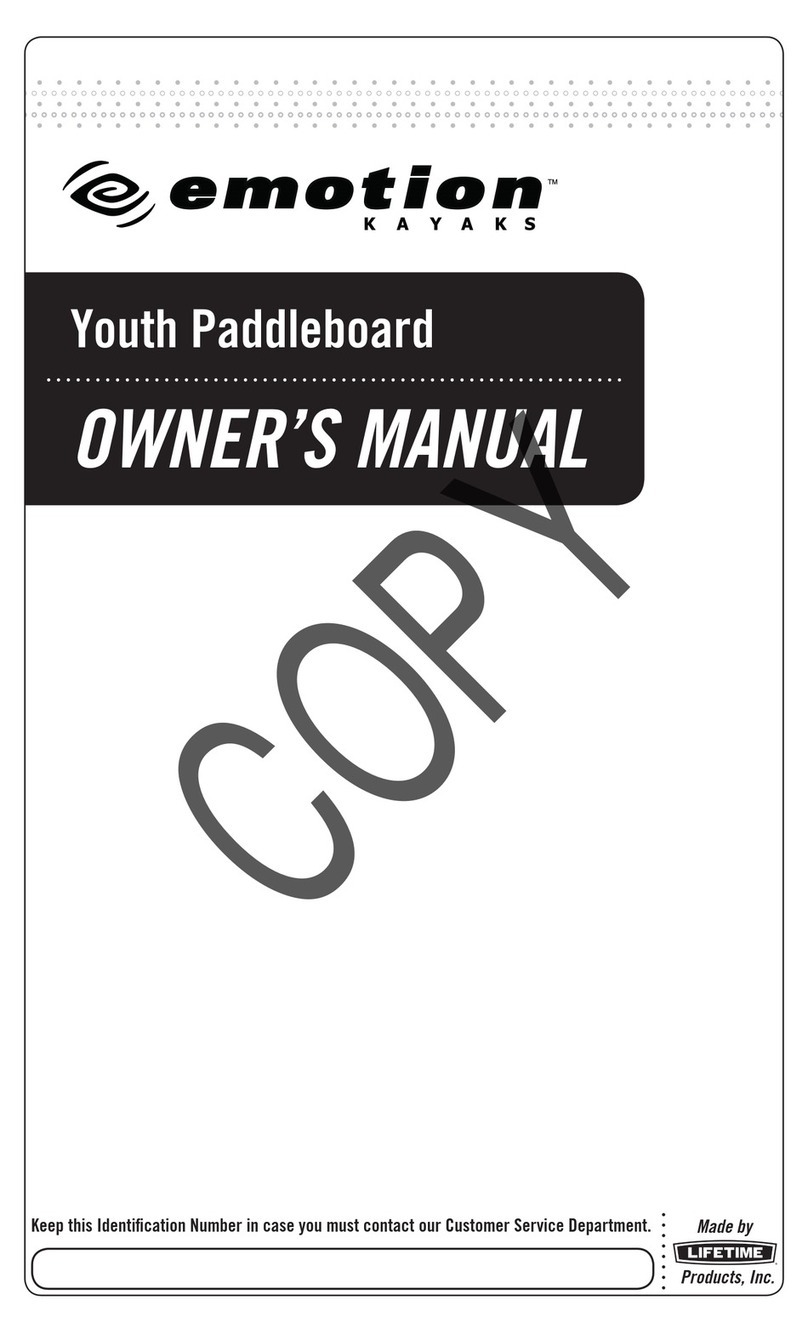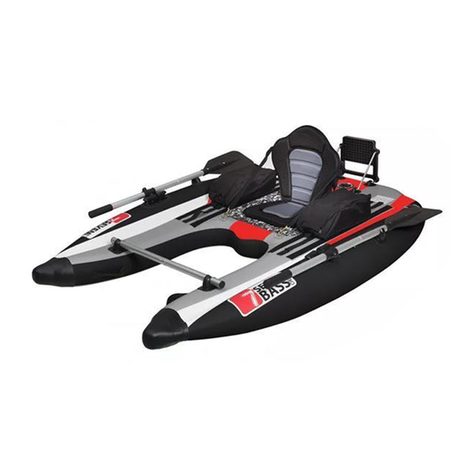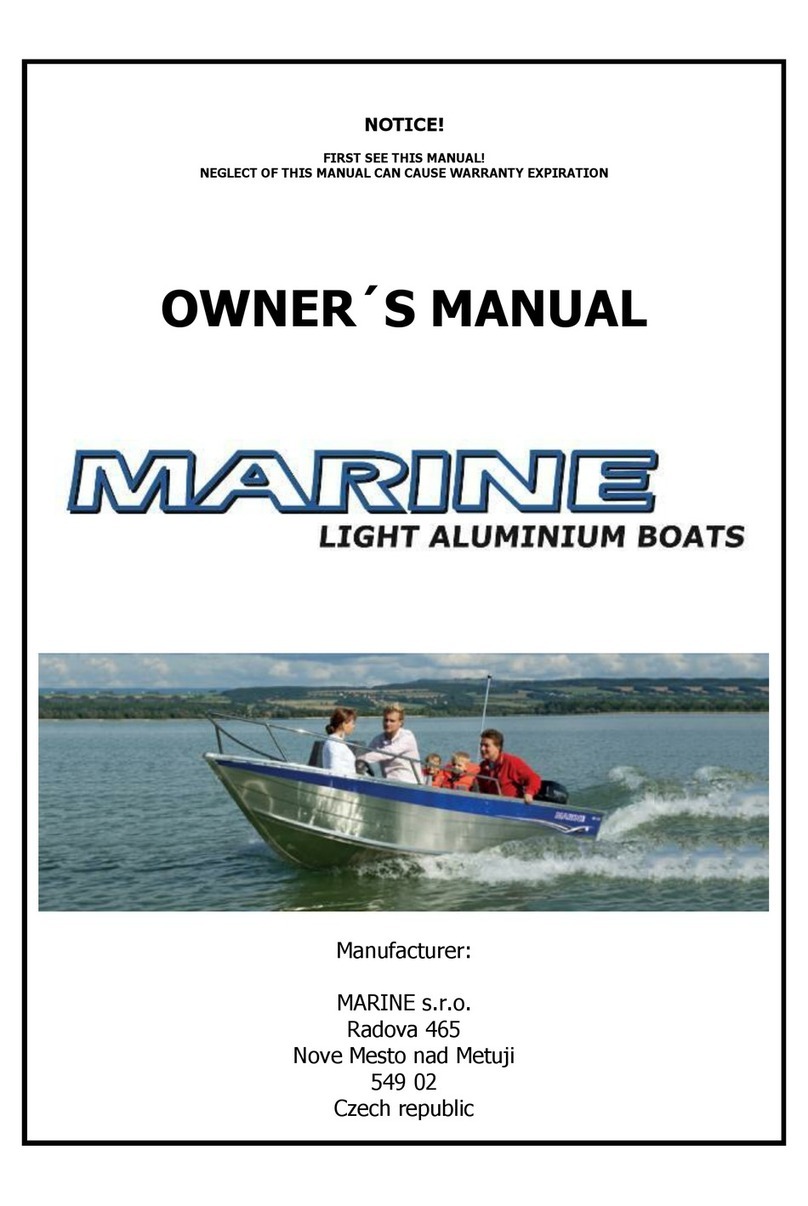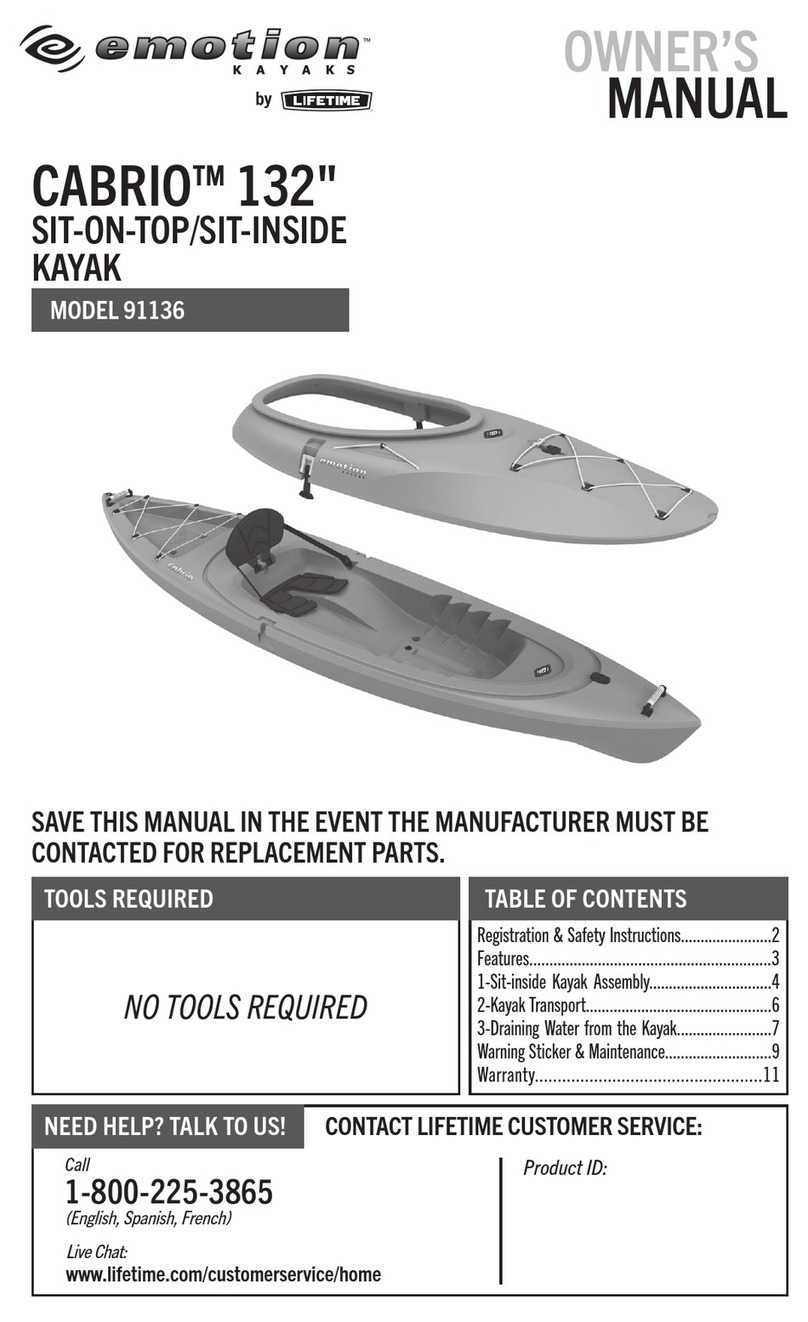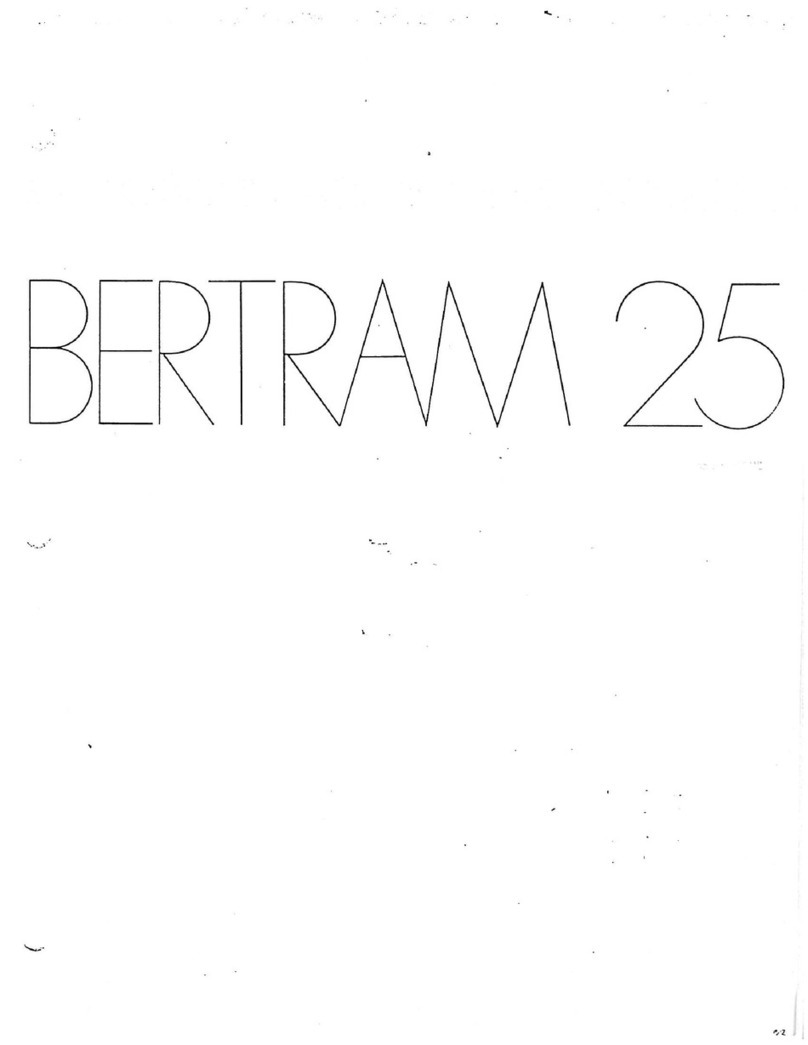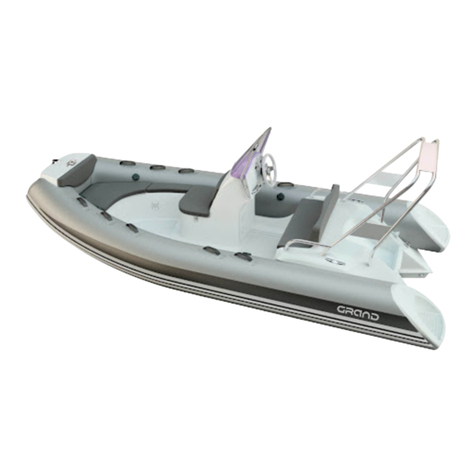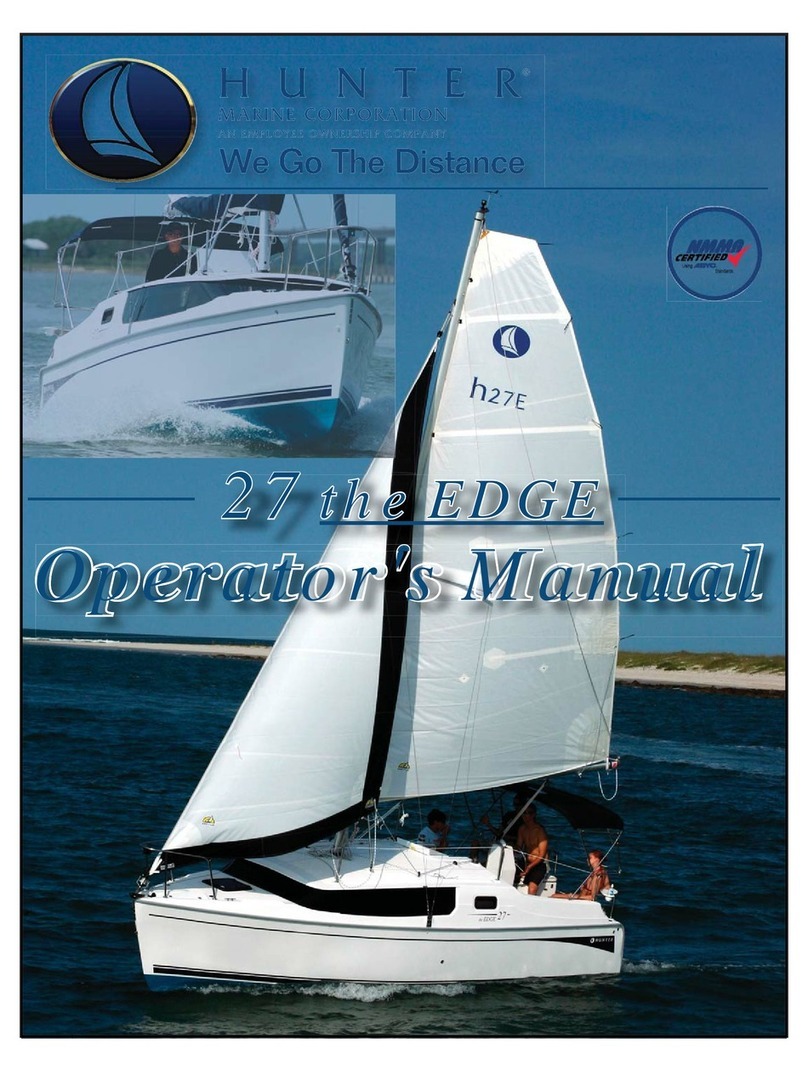e-motion electric pleasure boat User manual

www.emotion-boats.com
SHUPER GmbH,
Hermann-Riemschneider-Str.3,
D16816 Neuruppin, Germany,
Tel.: +49 339 140 4272,
Owner's instruction

1
Dear Owner!
We are glad that you have chosen the E.motion electric pleasure boat.
This manual will help you to understand the features of operation, care and mainte-
nance, and will also help to prevent unexpected problems in the operation.
Keep this operation manual in a safe place where you can easily access it when nec-
essary.
Important:
Please read these instructions carefully and study the e.motion boat before op-
eration.
This is very important from the point of view of your own safety and the safety of your
passengers.
Before going to sea, pay attention to the weather and try to get the forecast for the
near future. Make sure that the weather conditions correspond to the safe operation of
your boat and that you and your passengers will be able to cope with them.
At the end this booklet you will find information about the guarantee obligations of the
manufacturer. It is important to know which actions should be avoided to maintain the
warranty valid.
We wish you only positive
emotions with E.motion!

2
Contents:
1. Technical characteristics of E.motion.............................................3
2. General arrangements ......................................................................4
3. Configuration of the electric boat .................................................6
4. Options and accessories. ..................................................................6
5. Description and construction...........................................................7
5.1 Buoyancy block ..................................................................................................... 7
5.2 Drainage channels ................................................................................................ 7
5.3 Battery charge level indicator ............................................................................ 8
5.4 Emergency power switch .................................................................................... 8
5.5 Electric motors ...................................................................................................... 9
5.6 Engine protection ................................................................................................. 9
5.7 Awning.................................................................................................................... 9
6. Electrical system ................................................................................................ 10
7. Control .................................................................................................12
7.1 Joystick (speed control) ...................................................................................... 12
7.2 Joystick (direction control) ................................................................................. 12
8. Use of the trailer and the special E.motion handcart ..................13
9. Care and Maintenance.......................................................................14
9.1 Charger for batteries ......................................................................................... 14
9.2 Maintenance .......................................................................................................... 14
9.3 Propeller replacement ........................................................................................ 15
9.4 Troubleshooting.................................................................................................... 15
10. Storage..............................................................................................16
11. Safety precautions..........................................................................17
12. Warranty obligations ......................................................................18
13. Details on acceptance and sale ...................................................19
14. Marks on warranty repair...............................................................20

3
1. Technical characteristics of E.motion
Hull length 3.05 m
Hull width 1.75 m
Hull height 0.98 m
Keel depth at peak load conditions 0.38 m
Maximum weight of boat with engines 160 kg
Maximum accepted load with 4 batteries 150 kg/2 people + 120 kg/4 batteries =
270 kg
Maximum weight with passengers and
4 batteries
430 kg
Maximum allowed power of engines 2 x 0.566 kW / 1.50 h.p.
Cruise speed 5.5 km/h / 3 knots
Maximum number of passengers 2 persons
Hull material: fiberglass

4
2. General arrangements
1
2
3
24
4
14
31
33
33
32
33
15
16
23 23
17
18
19
20 21
22
30
27
5
6
8
8
10
11
12
13
10
25 26
97
28
29
Figure 1

5
1. hull top (deck and cockpit);
2. hull bottom;
3. transom;
4. control console assembly;
5. bonnet;
6. forward niche for battery
7. hatch cover of forward niche;
8. foot rest;
9. removable hatch cover of middle niche;
10. seat;
11. seat back;
12. armrest;
13. fender guard (along perimeter);
14. control joystick;
15. electric motor assembly (2 pcs);
16. motor protection frame (2 pcs);
17. awning arches;
18. awning arch support;
19. awning;
20. fittings of awning arches;
21. awning pullout string;
22. awning pullout string shackle;
23. rings (shackles) to fix the boat during transportation (3 pcs);
24. drain plug;
25. cupholder (2 pcs);
26. mooring cleat (2 pcs);
27. AM/FM radio with МР3 player;
28. moisture-proof speaker (2 pcs);
29. battery charge level indicator;
30. USB, AUX connector;
31. engine emergency switch;
32. LED course indicators;
33. oarlock base (2 pcs).

6
3. Configuration of the electric boat
The boat is available in the following standard configuration:
• boat hull and deck assembly
• 2 stationary electric motors with propeller assembly, power - 0.34 kW (0.46 h.p.)
• fender guard along perimeter
• 2 protection frames for engine and propeller
• 2 onboard chargers
• emergency power switch
• cord with bracket of power supply emergency switch
• onboard charger cable
• accumulator battery charge level indicator
• AM/FM radio with MP3 player, USB and AUX interfaces
• acoustic system (two moisture-proof speakers)
• radio aerial
• USB and AUX ports
• joystick to control the boat speed and direction
• 2 pockets for phones
• 2 cleats
• 3 transport rings (shackles)
• 2 cupholders
• 2 oarlock bases
• drain plug on transom
• soft upholstery of seats
• awning with arches and cover assembly
• cover for storage and transportation
• oars (2 pcs) complete with oarlocks
• automatic pump with float switch
• boat operating manual
• audio system operating manual
4. Options and accessories.
• AGMbatteries105A•h;
• reserve propeller for electric motor;
• peripheral light;
• special E.motion handcart;
• boat can be additionally completed with forced activation button for bilge pump, and
motometer.

7
5. Description and construction
The main material used in the construction of the hull is molded fiberglass on the basis
of polyester resin. At equipment fixing points there are located reinforcements and em-
bedded details. Connection of hull and deck made with stainless steel fasteners. Along
the perimeter of the board a fender guard is mounted that protects the boat from dam-
age. The main parts of the boat and the equipment layout are shown in Figure 1 (gener-
al arrangement).
In the middle part of the cockpit a control panel is located which includes: remote con-
trol joystick, radio with MP3 player, accumulator battery charge level indicator, direction
indicators, USB and AUX inputs, emergency power switch, and armrest. Seats, backrests
and armrest have upholstery. In the cockpit nose part, there is a hatch with a niche for
2 batteries. In the middle part of the cockpit under a demountable cover, there is a small
locker. The locker bottom is a demountable cover under which there is a niche for sew-
age from the top hull - a filtration sewage box. Seats have soft backrests. The aft deck
of a boat has a compartment with an opening cover (bonnet). In the stern compartment,
there is an under-bonnet with a steering mechanism installed on it. On the under-bonnet
there are located some elements of the electric system and 2 batteries. On the underwa-
ter part of the stern there are mounted stationary electric motors with propeller assem-
bly and motor protection frames. On the deck there are located mooring cleats, fittings of
awning fastenings and cupholders. In the forward and stern parts of the boat there are
transport (towing) rings (shackles). In the bottom hull, inside the boat, there is an auto-
matic pump with a return valve and an outlet connection installed portside in the middle
part of the boat.
5.1 Buoyancy block
Emergency buoyancy is achieved by placing expanded polystyrene blocks in the cavity
between the upper and lower parts of the shell. Buoyancy blocks are located in the
stern and bow parts of the boat.
5.2 Drainage channels
The boat is equipped with a system of scuppers, draining the water into the intrashell
space. The cockpit is equipped with a filtration storage box intended to collect sand and
garbage, which is under a demountable cover of the middle niche. The water should be
drained from the intrashell space on the bank through the transom plug located in the
lowest part of the transom.
Warning:
Boat launching with an open transom plug is prohibited!
We recommend leaving the transom plug open when the boat is on the shore to drain
the rain waters from the cockpit and dry the intrashell space.
Warning:
Before launching the boat, make sure the transom cap is in place and screwed
down tightly.

8
In case of an accident, or if a lot of water (more than 35 liters) got into the boat, the
automatic pump is switched on and the water is removed from the intrashell space over-
board. The pump is equipped with a return valve hindering coming outside water into the
boat through the outlet connection.
The automatic pump can be maintained and repaired through the inspection hatch
which is behind the hatch of the console, which is installed under a demountable cov-
er of the middle niche. The pump should be maintained in case of clogging of the suction
strainer and the maintenance is cleaning the strainer of garbage. The pump should be
maintained at last once a season. To exclude the clogging of the suction strainer of the
automatic pump, it is necessary to clean the filtration sewage box of sand and garbage
each time after the use of the boat on water.
5.3 Battery charge level indicator
At the top of the console there is a LED indicator that indicates the charge level of the
battery.
Active indicator warns about the presence of voltage in the circuit. The battery charge
level indicator is specially intended for the monitoring of the battery charge state when
using the boat.
The LED indicator informs the navigator of the E.motion boat about the battery charge
state and recommends the following actions.
•Green LEDs – the batteries are charged, the navigation range is without restrictions.
•Yellow LEDs – the batteries are half charged, it is necessary to navigate closer to the
destination.
•Red LEDs – the batteries are discharged, it is necessary to immediately move to the
destination. There is a minimum cruising range (250 – 500 m).
If the batteries are discharged completely, it is recommended to switch o the power
supply at the boat, having pulled o the bracket with emergency switch cord.
If after complete discharge of the batteries you have not reached the destination,
for the further movement it is necessary to use oars or services of a tower.
5.4 Emergency power switch
The electric boat is equipped with an emergency power switch assembly with a brack-
et on a cord. Emergency switch cord is designed for an emergency stop of engines (in case
the ship driver is overboard) and for power shut down. Power supply is turned o and the
engines stop working as soon as the bracket, attached to the end of the emergency cord
is pulled o the emergency switch. When the motors run, the emergency cord must be se-
curely attached to the wrist or the life jacket of the ship driver.
Warning:
If the emergency switch cord is not properly connected to the ship driver, then
in case when the ship driver falls overboard, the boat will completely go out of
control.

9
To ensure the safety of ship driver and passengers it is necessary to always put the
emergency cord bracket on the emergency switch, and the other end of the emergency
cord must be securely attached to the wrist of the ship driver or to his lifejacket.
Important:
Before leaving the boat and leave it for storage, be sure that the bracket of
the emergency cord is pulled off the emergency switch and the power supply is
turned off.
5.5 Electric motors
The electric boat is equipped with two noiseless electric motors running synchronously.
The motors are installed on the underwater part of the hull in the transom area.
Important:
Do not start the motors without water. motors should be immersed in the water
to prevent overheating. running engines in a dry mode can severely damage the
engine seals and cause them to break.
5.6 Engine protection
Engines protection frame is designed to protect the housing of the electric motors and
propellers from underwater objects and shoals while driving the boat. Protection is made
of stainless steel and is located in the engine installation area.
The frame does not guarantee absolute protection of engines and propellers. Therefore
it is necessary to make every possible eort to avoid collisions of the electric boat with
any underwater objects and shoals.
Warning:
Do not use the protective frame as a step for boarding! It is dangerous!
5.7 Awning
The electric boat is equipped with awning assembly with arches and a cover. Installa-
tion and removal of awning arcs is simple and convenient due to the use of quick-release
pins and clamps
Important:
With strong gusts of wind it is recommended to fold the awning into the stowed
position. (Fig. 2)

10
Figure 2
6. Electrical system
Electrical components installed by the boat manufacturer are shown in the diagram
(Fig. 3). The diagram also contains information on the labeling of wires and components
names.
Important:
Never attempt to make changes to the boat’s electrical system without the prior
approval of the manufacturer!

11
Figure 3

12
7. Control
The E.motion boat is equipped with an intuitive control knob - joystick mounted in
the middle part of the cockpit. The control panel is equipped with an armrest for the
convenience.
The joystick allows you to control the speed and direction of the boat simultaneously.
7.1 Joystick (speed control)
Speed control features eight fixed position of the joystick.
To move forward, forward gear speeds from «1» to «5» are used
(joystick is inclined forward).
To move backward use reverse gear speeds from «-1» to «-2»
(joystick is inclined towards the stern - backwards).
For a full stop, the neutral position («0») of the joystick is used.
(joystick is in vertical position)
Each higher number corresponds to the increase in the speed.
Important:
Control with joystick allows you to immediately change the speed of the boat while
moving in the same direction.
When changing the direction of motion (forward - backward) a full stop of the engine
is recommended.
When switching the speeds (forward - backward) it is necessary to lock the lever in the
neutral position for 1-2 seconds, allowing the engine to stop.
Change of direction without a full stop can damage the engine.
7.2 Joystick (direction control)
Direction control is performed by means of joystick deviations from the vertical axis to
the right or to the left side.
When the joystick is inclined to the right side the boat turns right.
When the joystick is inclined to the left side the boat turns left.
Important:
Be attentive with the people swimming near your boat! always turn off the
engines — neutral («0») joystick position (joystick in vertical position), if there
are people near the boat.
Please commensurate speed and course in relation to wave and weather
conditions.

13
8. Use of the trailer and the special E.motion handcart
For transportation, launching and recovery of the E.motion electric pleasure boats
you can use trailers for aquatic equipment or a special E.motion handcart with supports,
adapted to the contours of the boat.
Trailers for aquatic equipment are designed for the transportation of boats by car on
the roads of general use. In such trailers, the position of the supports can be adjusted to
provide the best support to the boat shell. While adjusting the supports, make sure that
the load is distributed evenly between them and that there is no load localization on the
boat shell. The trailer winch pulling force should be directed horizontally or down.
In any case, read the manufacturer’s instructions before using the trailer.
Special E.motion handcart is intended for transportation of the boat for short distances
by one or two people.
Important:
Towing of the handcart with a car on public roads is not allowed!
The special E.motion handcart can be purchased at all trading organizations that sell
the E.motion boats.
Important:
To avoid deformations and damages in the boat hull, it is not recommended to use
other handcarts not adapted for contours of the e.motion boat hull.
Read the manufacturer’s instructions before using the handcart.

14
9. Care and Maintenance
9.1 Charger for batteries
For the best results of the electric boat operation, it is recommended to charge the
batteries fully before each use.
The electric boat is equipped with a built-in charger. To charge the battery you must
use a special cable (supplied with built-in charger) for connection to a source of electric
power with AC voltage 220 - 230 V, 50 Hz.
Important:
Before removing or inserting the batteries, make sure that all switches are in the
off position!
Refer to the instruction manual of the charger to find the appropriate settings of
charging.
9.2 Maintenance
If you are using a boat constantly throughout the navigation season, it should be
lifted ashore at least 1 time per week. The hull should be checked for damage, and all
the systems should be checked and cleaned to ensure reliable operation. To reduce the
amount of maintenance works, recover the boat from the water and keep it ashore, if you
do not plan to use it for a long time.
Regularly check the condition of motor and protection frame mountings, and wire
connections. Regularly lubricate the moving parts of the steering mechanism. For this
purpose, use silicone spray lubricants. After each launching, open the transom plug to
drain the water from the intrashell space. Keep the bow of the boat lifted up when
draining the water.
After each launching, remove sand and garbage from an external surface of the boat.
Regularly clean the filtration sewage box which is under a demountable cover of the
middle niche.
At least once a season, maintain the automatic pump. The automatic pump can be
maintained and repaired through the inspection hatch which is behind the hatch of the
console, which is installed under a demountable cover of the middle niche. The pump
should be maintained ahead of schedule in case of clogging of the suction strainer and
the maintenance is cleaning the strainer of garbage. To exclude the clogging of the
suction strainer of the automatic pump, it is necessary to clean the filtration sewage box
of sand and garbage each time after the use of the boat on water.
Use mild detergents and sponges to clean the outer surface of your boat. Avoid
solvents or aggressive detergents because they may leave marks on the surface. Take
care not to scratch the outer coating.
Use a damp cloth to clean soft vinyl seats of dust and stains. Clean the awning with
water and common detergents for fabrics, using the brush to remove stubborn stains.
After cleaning, rinse the awning thoroughly with water and dry it in a stretched state.
After use of engines always check the propellers for possible damage, and clean them
of debris and algae. After that, rinse them with fresh water to remove salt, sand and dirt.

15
9.3 Propeller replacement
Before you do anything with the propeller, ensure that the cables to the battery are
disconnected.
You can remove the propeller simply by loosening and removing the nuts using a
special key included in the scope of supply. It is necessary to hold the propeller by hands
while loosening the nuts, so that the propeller would not rotate. Never attempt to loosen
the nut with a hammer or a similar tool, as this may cause damage to the lock nut and the
shaft of the motor. After removing the lock nut you can remove the propeller.
When re-installing the propeller into its place, align the slots and grooves of the
propeller and the shaft, otherwise the propeller won’t be locked in place.
9.4 Troubleshooting.
Problem Possible cause and Solution
Loss of speed 1. Check for clogging elements (algae, lines, etc.)
and clean the propeller off them.
2. Check battery power condition.
3. Check the reliability of contacts at
accumulator battery terminals.
Engine noise and vibrations 4. Check for clogging elements (algae, lines, etc.)
and clean the propeller of them.
5. Check the propeller for damage.
6. The propeller shaft may be bent. Remove the
propeller and start the engine, observing the
propeller shaft. If the shaft is bent, contact the
boat seller.

16
10. Storage
It is extremely important to clean the boat and maintain it before long (winter) storage.
Without doing this, you will significantly increase the cost of maintenance before the
next launching, because the combination of salt, moisture and dirt significantly worsens
the condition of most components of your boat.
Thoroughly wash the electric boat. Clean the containers for things and batteries as
well.
Clean the filtration sewage box which is under a demountable cover of the middle
niche.
Maintain the automatic pump through the inspection hatch which is behind the hatch
of the panel installed under a demountable cover of the middle niche. Clean the pump
suction strainer.
Disconnect and remove the batteries, charge them and store in a dry, well-ventilated
warm place.
Apply silicone grease to the mechanisms of the steering gear and the joystick.
Leave the hatches open for ventilation. During storage it is recommended to place the
boat bow slightly raised; drain plug should be open.
In winter, do not leave the boat in the freezing cold: it can damage the electrical
components and motors.

17
11. Safety precautions
Important:
The boat is designed for use in small lakes, ponds, rivers and canals where the
wind force is no more than 4, the current speed is no more than 3 km/hour, and
the wave height is no higher than 0.3 m.
Bad weather, strong winds and big waves are the reason of most accidents on the
water. Always follow the weather forecast and plan your sail accordingly.
Important:
Use life jackets while boating.
Warning:
Never overestimate capabilities of your boat in a strong wind, the current more
than 3 km/hour and in adverse weather conditions.
Before launching the boat, make sure that the plug on the transom is closed, and
the boat is equipped with everything necessary.
Always follow the manufacturer’s recommendations for the maximum load and
the maximum number of passengers.
Your boat is equipped with electric motors. you should never attempt to access
the engines, if you do not disconnect the power source.
Important:
This boat is not designed for use as a platform for swimming or snorkeling.
In the case of independent alteration or modernization of the boat, the manufacturer
is only liable in the event when the changes are agreed and approved in writing by the
manufacturer, and provided that the technology of introduction of changes has been
carefully observed.
Important:
The manufacturer of electric boats does not bear responsibility for any accidents
due to improper operation, or use of the boat in any way other than as directed.

18
12. Warranty obligations
The manufacturer guarantees the quality construction of each boat, according to their tech-
nical data sheets, as well as reliable operation within 12 months from the date of purchase,
provided that the consumer follows the rules of use, transportation and storage described in
this manual.
Fiberglass housing elements warranty is valid for 24 months.
This warranty does not cover damages or failures occurred as a result of: improper mainte-
nance or repairs; improper storage; negligent handling; non intended use; unauthorized modi-
fication; repair of engines or components at the stations not authorized by the manufacturer;
damage caused by transportation, loading or unloading.
The guarantee does not cover the following cases:
• formation of cracks, scratches, chipping and punctures on the surface of the gel coat, loss
of color and luster;
• formation of stains or tears in the upholstery, fading, and burning out of colors of awnings,
fabrics and trims;
• damage caused by operation of optional equipment and accessories not supplied with the
boat at the time of sale.
• damages resulted from the incidents;
• damages incurred as a result of participation in competitions;
The warranty does not cover normal wear and tear, shortcomings not influencing the nor-
mal operation of the boat.
In the event of failure of one or more components of the boat, which occurred through the
fault of the manufacturer, the purchaser must notify the seller or manufacturer for warranty
claims no later than 30 days after the discovery of the defect.
The manufacturer reserves the right to:
• carry out its own assessment of the warranty case, identify the circumstances aecting the
warranty case validity confirmation;
• change or improve the design of the boat without obligation to modify the previously man-
ufactured boats.
The manufacturer is not liable for loss of use of the boat, loss of time and inconvenience
caused by the maintenance, repair or replacement under warranty. Transportation costs for
the boat to the service stations for repair or replacement under warranty are paid by the buyer.
Warranty begins on the date of purchase and if the date of sale is indicated in the boat pass-
port.
The guarantee does not apply to the boats used for commercial purposes.
No warranty claims will not be accepted, if the date of sale in the boat passport is missing.
Address:
SHUPER GmbH, Hermann-Riemschneider-Str.3, D16816 Neuruppin, Germany,
Tel.: +49 339 140 4272,
E-mail: wp@shuper.de
www.emotion-boats.com

19
13. Details on acceptance and sale
Electric pleasure boat E.motion,
factory No. _________________________
Quality control
Date of issue: ___________ ____, 201__
______________________________ (_________________________________________)
(signature) (full name)
Company Seal
Name and address of trading organization
______________________________________________________________________________
Date of sale: ___________ ____, 201__
Seller
______________________________ (_________________________________________)
(signature) (full name)
Company Seal
Table of contents
Other e-motion Boat manuals
Popular Boat manuals by other brands
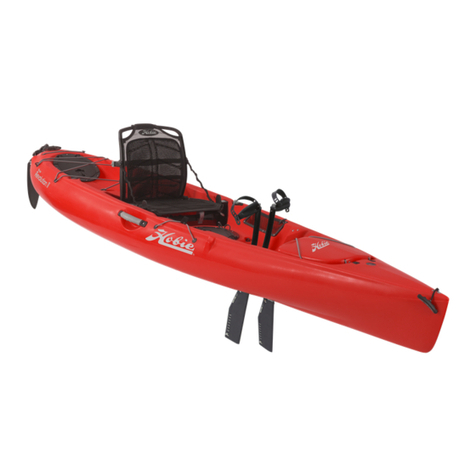
Hobie
Hobie Mirage Drive manual

Creek Company
Creek Company OUTDOOR DISCOVERY CRAFT ODC 1624 Assembly instructions
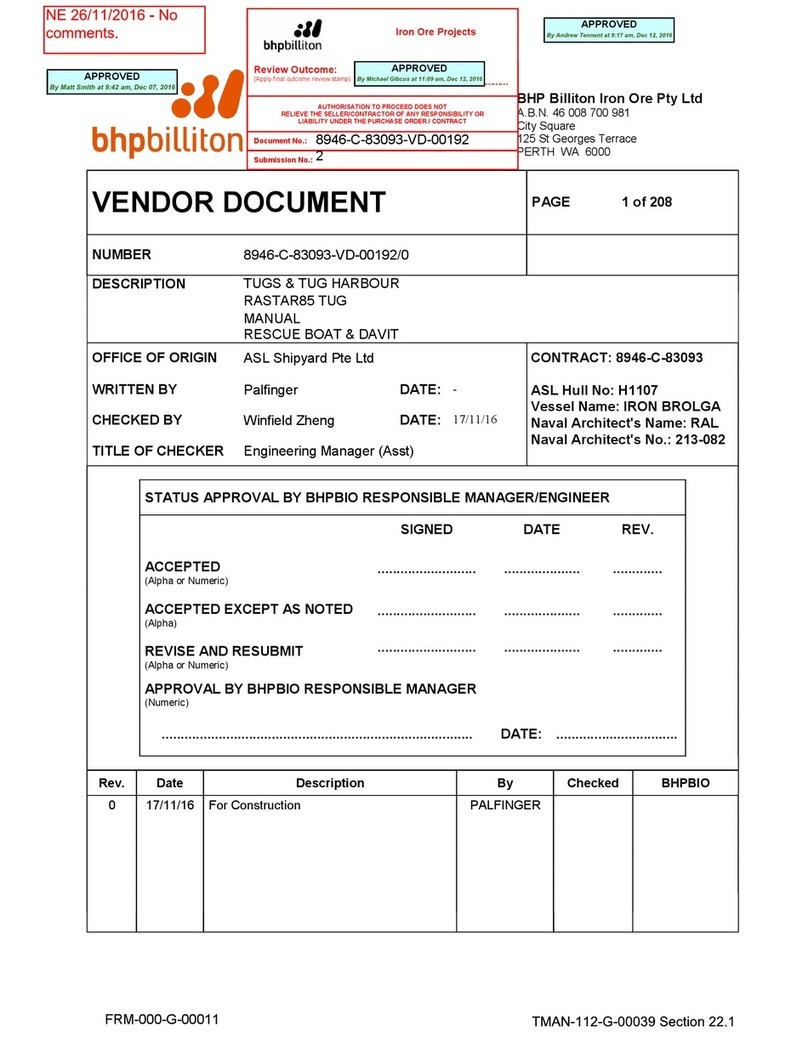
Palfinger
Palfinger RSQ 450 Series Operation and maintenance manual
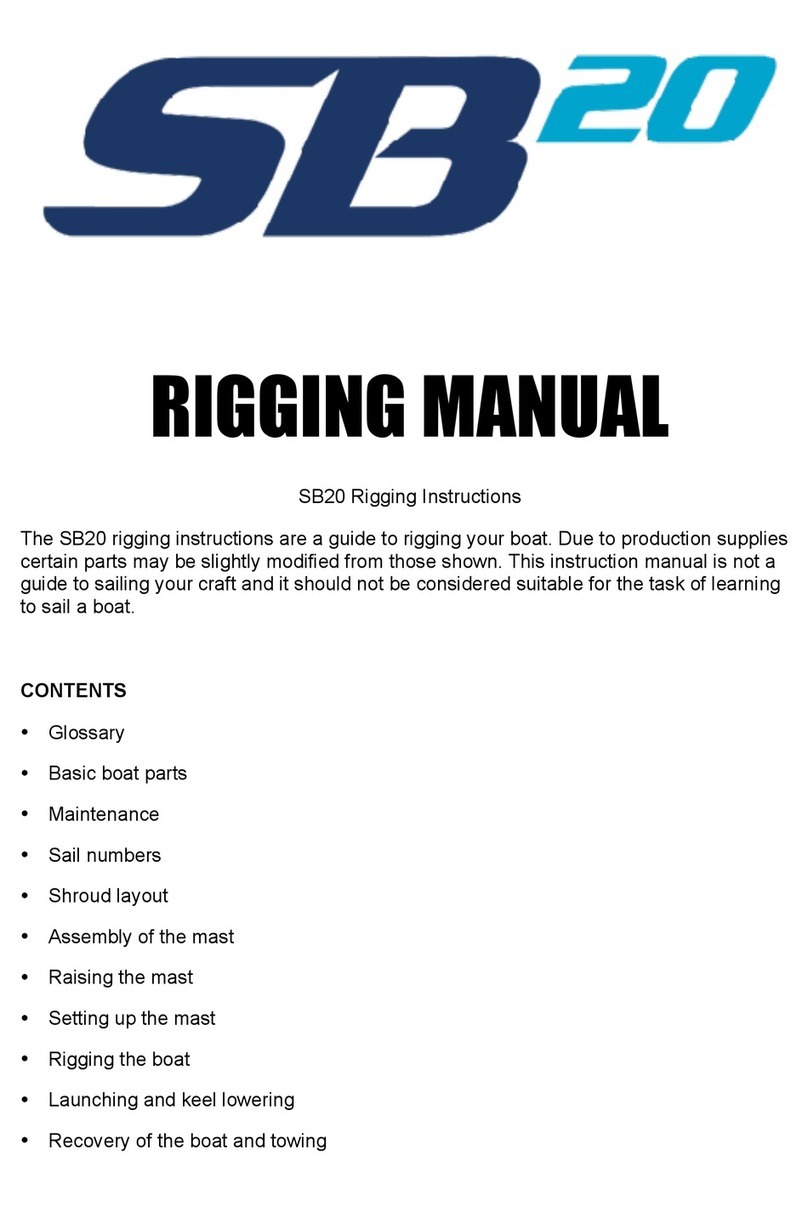
Laser
Laser SB20 Rigging manual

OVINGTON BOATS
OVINGTON BOATS Musto Skiff Rigging guide

Monterey
Monterey Sport Cruiser 260SCR owner's manual
